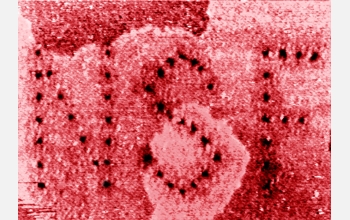Home > Press > Researchers Carve with Electricity at the Nanometer Scale
Abstract:
Process may yield miniscule molecular detection devices, semiconducting connectors and molecular sieves
Researchers Carve with Electricity at the Nanometer Scale
August 18, 2005
By applying electric current through a thin film of oil molecules, engineers have developed a new method to precisely carve arrays of tiny holes only 10 nanometers wide into sheets of gold. The new system, called Electric Pen Lithography (EPL), uses a scanning-tunneling microscope, fitted with a tip sharpened to the size of a single atom, to deliver the charge through the dielectric oil to the target surface.
With EPL, the researchers can both see and manipulate their target at the same time, all without the constraints of the vacuum chamber required by similar processes. With such tight control, the researchers hope the relatively inexpensive procedure will have applications for crafting single DNA detection devices such as nanopores, nanoscale interconnects in biological and semiconducting devices, molecular sieves for protein sorting and nanojets for fuel or drug delivery.
Mechanical engineer Ajay Malshe of the University of Arkansas, his students Kumar Virwani and Devesh Deshpande, and co-investigator Kamalakar Rajurkar of the University of Nebraska, Lincoln will present the new innovation at the International Institution for Production Engineering Research General Assembly in Antalya, Turkey, Aug. 21-27.
For additional information, see the University of Arkansas release:
Oil Worth Its Weight in Gold in Directed Nanomachining
This research was supported by NSF Grant #0423698
Collaborative Research: Development Of Nano-Electrical Discharge Machining (NANO-EDM) For Advanced Manufacturing
About the National Science Foundation:
The National Science Foundation (NSF) is an independent federal agency that supports fundamental research and education across all fields of science and engineering, with an annual budget of nearly $5.47 billion. NSF funds reach all 50 states through grants to nearly 2,000 universities and institutions. Each year, NSF receives about 40,000 competitive requests for funding, and makes about 11,000 new funding awards. The NSF also awards over $200 million in professional and service contracts yearly.
For more information, please visit www.NSF.gov
Media Contacts:Joshua A. Chamot
NSF
(703) 292-7730
jchamot@nsf.gov
Melissa Blouin
University of Arkansas
(479) 575-3033
blouin@uark.edu
Program Contacts:
Kevin W. Lyons
NSF
(703) 292-5365
klyons@nsf.gov
Principal Investigators:
Ajay P. Malshe
University of Arkansas
(479) 575-6561
apm2@engr.uark.edu
Related Websites:
Ajay Malshe homepage
Copyright © NSF
If you have a comment, please Contact us.
Issuers of news releases, not 7th Wave, Inc. or Nanotechnology Now, are solely responsible for the accuracy of the content.
| Related News Press |
Possible Futures
![]() Spinel-type sulfide semiconductors to operate the next-generation LEDs and solar cells For solar-cell absorbers and green-LED source October 3rd, 2025
Spinel-type sulfide semiconductors to operate the next-generation LEDs and solar cells For solar-cell absorbers and green-LED source October 3rd, 2025
Announcements
![]() Rice membrane extracts lithium from brines with greater speed, less waste October 3rd, 2025
Rice membrane extracts lithium from brines with greater speed, less waste October 3rd, 2025
![]() Researchers develop molecular qubits that communicate at telecom frequencies October 3rd, 2025
Researchers develop molecular qubits that communicate at telecom frequencies October 3rd, 2025
![]() Next-generation quantum communication October 3rd, 2025
Next-generation quantum communication October 3rd, 2025
![]() "Nanoreactor" cage uses visible light for catalytic and ultra-selective cross-cycloadditions October 3rd, 2025
"Nanoreactor" cage uses visible light for catalytic and ultra-selective cross-cycloadditions October 3rd, 2025
Tools
![]() Japan launches fully domestically produced quantum computer: Expo visitors to experience quantum computing firsthand August 8th, 2025
Japan launches fully domestically produced quantum computer: Expo visitors to experience quantum computing firsthand August 8th, 2025
![]() Rice researchers harness gravity to create low-cost device for rapid cell analysis February 28th, 2025
Rice researchers harness gravity to create low-cost device for rapid cell analysis February 28th, 2025
|
|
||
|
|
||
| The latest news from around the world, FREE | ||
|
|
||
|
|
||
| Premium Products | ||
|
|
||
|
Only the news you want to read!
Learn More |
||
|
|
||
|
Full-service, expert consulting
Learn More |
||
|
|
||









